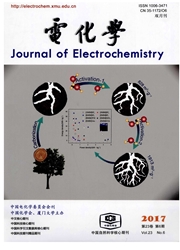

 中文摘要:
中文摘要:
将辣根过氧化物酶(HRP)固定到凹凸棒石粘土(Attapulgite,简称凹土)表面,制得HRP-凹土纳米复合物(HRP-Attapulgite),并采用电化学阻抗、紫外光谱和红外光谱技术表征了HRP固定化过程.HRP-Attapulgite电化学性质测试表明,凹土能促进HRP的直接电子转移,其循环伏安曲线有一对良好的氧化还原峰,峰电位分别为Epc=-370 mV,Epa=-300 mV,式量电位E0′=-335 mV.凹土表面HRP的H2O2响应电流与浓度(0.3-75μmol·L-1)呈线性关系.该电极可用于巨噬细胞中微量H2O2的测定.
 英文摘要:
英文摘要:
The nanostructured attapulgite clay was employed as a support matrix for immobilizing horseradish peroxidase(HRP).FTIR and electrochemical methods demonstrated that HRP had been effectively assembled on attapulgite surface with the formation of HRP-Attapulgite nanocomposites.The HRP-Attapulgite hybrid was deposited on the glassy carbon(GC) electrode forming the HRP-Attapulgite/GC electrode.Cyclic voltammetric results showed a pair of well-defined redox peaks,which were ascribed to direct electron transfer(DET) of HRP,with the formal potential E0′=-335 mV(vs.SCE) in the phosphate buffer solution(PBS,pH 7.0).The dependence of E0′on solution pH indicated that DET reaction of HRP was coupled with proton transfer.The developed electrode revealed a good electrocatalytical activity toward the reduction of H2O2.The electrocatalyic current was linear to the concentration of H2O2 in the concentration range of 0.3 to 75 μmol·L-1with high sensitivity((53 ± 2) μA·(mmol·L-1)-1·cm-2)and low detection limit((0.10 ± 0.05) μmol·L-1).Moreover,the HRP-Attapulgite/GC electrode was used to detect the level cellular H2O2 released from the Macrophages cells(RAW 264.7).Therefore,an electrochemical approach for detection of cellular H2O2 based on HRP-Attapulgite hybrid was developed.This study has not only established a novel approach to detect cellular H2O2,but also provided a general route for fabricating attapulgite-based biosensing platform via assembling enzymes/proteins on attapulgite surface,expanded the scope of attapulgite applications to the field of bioelectroanalytical chemistry and cellular biology.
 同期刊论文项目
同期刊论文项目
 同项目期刊论文
同项目期刊论文
 Aptamer-Guided Silver?Gold Bimetallic Nanostructures with Highly Active Surface-Enhanced Raman Scatt
Aptamer-Guided Silver?Gold Bimetallic Nanostructures with Highly Active Surface-Enhanced Raman Scatt Graphyne As a Promising Metal-Free Electrocatalyst for Oxygen Reduction Reactions in Acidic Fuel Cel
Graphyne As a Promising Metal-Free Electrocatalyst for Oxygen Reduction Reactions in Acidic Fuel Cel Fluorescence quenching of gold nanoparticles integrating with a conformation-switched hairpin oligon
Fluorescence quenching of gold nanoparticles integrating with a conformation-switched hairpin oligon Microscopic effects of the bonding configuration of nitrogen-doped graphene on its reactivity toward
Microscopic effects of the bonding configuration of nitrogen-doped graphene on its reactivity toward G-quadruplex DNAzyme-based electrochemiluminescence biosensing strategy for VEGF165detection: Combin
G-quadruplex DNAzyme-based electrochemiluminescence biosensing strategy for VEGF165detection: Combin Multidecker sandwich complexes VnBenn+1 (n = 1, 2, 3) as stronger electron donor relative to ferroce
Multidecker sandwich complexes VnBenn+1 (n = 1, 2, 3) as stronger electron donor relative to ferroce Synthesis of magnetic Fe3O4-Au hybrids for sensitive SERS detection of cancer cells at low abundance
Synthesis of magnetic Fe3O4-Au hybrids for sensitive SERS detection of cancer cells at low abundance Synthesis of hollow mesoporous Pt–Ni nanosphere for highly active electrocatalysis toward the methan
Synthesis of hollow mesoporous Pt–Ni nanosphere for highly active electrocatalysis toward the methan DNA strand-displacement-induced fluorescence enhancement for highly sensitive and selective multiple
DNA strand-displacement-induced fluorescence enhancement for highly sensitive and selective multiple High specific detection and near-infrared photothermal therapy of lung cancer cells with high SERS a
High specific detection and near-infrared photothermal therapy of lung cancer cells with high SERS a Composition- and aspect-ratio-dependent electrocatalytic performances of one-dimensional aligned Pt–
Composition- and aspect-ratio-dependent electrocatalytic performances of one-dimensional aligned Pt– Signal Amplification of Graphene Oxide Combining with Restriction Endonuclease for Site-Specific Det
Signal Amplification of Graphene Oxide Combining with Restriction Endonuclease for Site-Specific Det Aptamer-modified graphene oxide for high efficient loading and cancer cell-specific delivery of anti
Aptamer-modified graphene oxide for high efficient loading and cancer cell-specific delivery of anti Nitrogen/carbon atomic ratio-dependent performances of nitrogen-doped carbon-coated metal oxide nano
Nitrogen/carbon atomic ratio-dependent performances of nitrogen-doped carbon-coated metal oxide nano Highly sensitive methyltransferase activity assay and inhibitor screening based on fluorescence quen
Highly sensitive methyltransferase activity assay and inhibitor screening based on fluorescence quen Probing the anticancer-drug-binding-induced microenvironment alterations in subdomain IIA of human s
Probing the anticancer-drug-binding-induced microenvironment alterations in subdomain IIA of human s Multidecker Sandwich Cluster VnBenn +1(n = 1, 2, 3, 4) as a Polarizable Bridge for Designing 1D Seco
Multidecker Sandwich Cluster VnBenn +1(n = 1, 2, 3, 4) as a Polarizable Bridge for Designing 1D Seco Fluorescence quenching of graphene oxide combined with the site-specific cleavage of restriction end
Fluorescence quenching of graphene oxide combined with the site-specific cleavage of restriction end Designing activatable aptamer probes for simultaneous detection of multiple tumor-related proteins i
Designing activatable aptamer probes for simultaneous detection of multiple tumor-related proteins i Fluorescence quenching of graphene oxide integrating with the site-specific cleavage of the endonucl
Fluorescence quenching of graphene oxide integrating with the site-specific cleavage of the endonucl Electrochemical probing the solution pH-induced structural alterations around the heme group in myog
Electrochemical probing the solution pH-induced structural alterations around the heme group in myog Catalytic signal amplification of gold nanoparticles combining with conformation-switched hairpin DN
Catalytic signal amplification of gold nanoparticles combining with conformation-switched hairpin DN Synthesis of Nitrogen-Doped Graphene Quantum Dots at Low Temperature for Electrochemical Sensing Tri
Synthesis of Nitrogen-Doped Graphene Quantum Dots at Low Temperature for Electrochemical Sensing Tri 期刊信息
期刊信息
